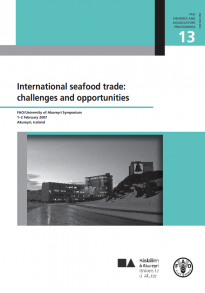Markets for On-board Handling on Freezer Vessels
Freezing is the main method of processing fish for food use, accounting for 53% of total processed fish for human consumption. In developed countries, the proportion of fish that is frozen has been constantly increasing.
Freezing and frozen storage of fish can give a storage life of more than one year, if properly carried out and depending on the product. Freezing has enabled fishing vessels to remain at sea for long periods, and allowed the stockpiling of fish during periods of good fishing and high catching rates, as well as widened the market for fish products of high quality.
One of the critical driving factors for the successful evolution of cold chains is the type, location and size of market for frozen fish. According to an FAO policy brief on agroindustry, despite the challenges, economic and demographic trends in sub-Saharan Africa, including a growing middle class and increasing urbanization, offer significant opportunities for reaching more rapidly the “critical mass” needed for cold chain market development in the region.
Reliable and efficient cold chains contribute not only to reducing food loss and waste (FLW), but also to improving the technical and operational efficiency of the food supply chain. Cold chains thus facilitate compliance with quality and safety requirements and promote market growth stimulating increases in production.
Encouraging the freezing of fish and proper use of cold storage for FLW reduction will rely on consumer demand and perceptions of frozen fish and fish products. Frozen fish retailers therefore have a role to play in educating buyers and consumers of the benefits of frozen fish, how to store it, thaw it and take care of products, to ensure quality is maintained and FLW prevented.
Flash Freezing as a Market Differentiator in U.S.A.
Flash Freezing as a Market Differentiator in U.S.A.
With so many uncertainties in today’s seafood market, community-based U.S. fishermen are looking for a market differentiator that encapsulates the values consumers desire most: quality and freshness–while also delivering social and environmental benefits. Flash-freezing seafood is one way to improve traceability, quality of seafood products, reduce waste, as well as support remote fishing communities. Combined with careful handling, flash-freezing essentially “pauses” the degradation process, thereby increasing a product’s shelf life. This enables small-scale producers to aggregate and distribute their high-quality seafood direct to consumers through a short and transparent supply chain.
In July 2016, partners received a $100,000 grant from the National Fish and Wildlife Foundation’s Fisheries Innovation Fund aimed at testing current consumer perceptions that frozen seafood is of lesser quality and exploring market opportunities for flash-frozen seafood.
Results indicated the potential to shift consumer perception in favour of high-quality flash-frozen seafood. If, for example, consumers could receive better information about the added-value of flash-frozen fish, the implications for small-scale fishers and supporting regional seafood economies could be tremendous.
Key Publications
International seafood trade: challenges and opportunities The report presents views regarding the risks and challenges inherent to the recent developments in international seafood trade. |
| |
Developing the cold chain in the agrifood sector in sub-Saharan Africa Policy brief based on the proceedings of a Regional workshop on the use of the cold chain in the development of agriculture and agro industries in sub-Saharan Africa. | ||
|
Overview of current attitudes and perceptions towards chilled and frozen seafood. |
More Resources
More Resources
31 October 2023
10 April 2023
01 April 2023














